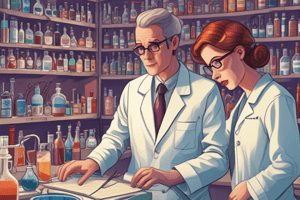Podcast
Questions and Answers
What is the primary purpose of proper specimen collection?
What is the primary purpose of proper specimen collection?
- To prevent contamination and false positives/negatives
- To reduce the risk of infection transmission
- To ensure accurate test results (correct)
- To ensure patient safety and comfort
Which type of specimen collection involves breaking the skin or entering a body cavity?
Which type of specimen collection involves breaking the skin or entering a body cavity?
- Non-invasive
- Venipuncture
- Invasive (correct)
- Capillary puncture
What is an important consideration before collecting a specimen?
What is an important consideration before collecting a specimen?
- Labeling and identification
- Chain of custody
- Patient preparation (correct)
- Transportation and storage
Which of the following is a type of specimen collection technique?
Which of the following is a type of specimen collection technique?
What is the purpose of labeling and identification in specimen collection?
What is the purpose of labeling and identification in specimen collection?
What is the purpose of quality control measures in specimen collection?
What is the purpose of quality control measures in specimen collection?
Flashcards are hidden until you start studying
Study Notes
Types of Specimen Collection
- Invasive: involves breaking the skin or entering a body cavity, e.g. blood draws, biopsies, surgical procedures
- Non-invasive: does not break the skin or enter a body cavity, e.g. urine, stool, saliva, mouth swabs
Importance of Proper Specimen Collection
- Ensures accurate test results
- Prevents contamination and false positives/negatives
- Maintains patient safety and comfort
- Reduces risk of infection transmission
Pre-Collection Considerations
- Patient preparation: fasting, hydration, medication restrictions
- Collection timing: scheduling, timing of collection relative to medication administration, meals, etc.
- Equipment and supplies: selection of appropriate materials, e.g. needles, tubes, swabs
Specimen Collection Techniques
- Venipuncture: blood collection from a vein
- Capillary puncture: blood collection from a capillary (e.g. fingerstick)
- Urine collection: midstream, clean-catch, or catheterized collection
- Swab collection: nasal, oral, vaginal, or wound swabs
Post-Collection Considerations
- Labeling and identification: accurate labeling and tracking of specimens
- Transportation and storage: proper handling, storage, and transportation of specimens
- Chain of custody: documentation of specimen handling and transfer
Quality Control and Assurance
- Quality control measures: monitoring and assessment of specimen quality
- Quality assurance protocols: verification of specimen collection and handling procedures
Types of Specimen Collection
- Invasive specimen collection involves breaking the skin or entering a body cavity, including blood draws, biopsies, and surgical procedures.
- Non-invasive specimen collection does not break the skin or enter a body cavity, including urine, stool, saliva, and mouth swabs.
Importance of Proper Specimen Collection
- Accurate test results rely on proper specimen collection to prevent contamination and false positives/negatives.
- Proper specimen collection maintains patient safety and comfort, reducing the risk of infection transmission.
Pre-Collection Considerations
Patient Preparation
- Fasting may be required before specimen collection.
- Hydration is important before collecting certain specimens.
- Medication restrictions may apply before specimen collection.
Collection Timing
- Collection timing is critical, considering factors like medication administration and meals.
Equipment and Supplies
- Appropriate equipment and supplies, such as needles, tubes, and swabs, must be selected for specimen collection.
Specimen Collection Techniques
Blood Collection
- Venipuncture involves collecting blood from a vein.
- Capillary puncture involves collecting blood from a capillary, often via fingerstick.
Urine Collection
- Midstream urine collection involves collecting urine mid-stream to minimize contamination.
- Clean-catch urine collection involves cleaning the genital area before collecting urine.
- Catheterized urine collection involves using a catheter to collect urine.
Swab Collection
- Nasal swabs are used to collect specimens from the nasal cavity.
- Oral swabs are used to collect specimens from the mouth.
- Vaginal swabs are used to collect specimens from the vagina.
- Wound swabs are used to collect specimens from wounds.
Post-Collection Considerations
Labeling and Identification
- Specimens must be accurately labeled and tracked to ensure correct identification.
Transportation and Storage
- Specimens must be handled, stored, and transported properly to prevent damage or contamination.
Chain of Custody
- Documentation of specimen handling and transfer is essential to maintain the chain of custody.
Quality Control and Assurance
Quality Control Measures
- Quality control measures monitor and assess specimen quality to ensure accuracy.
Quality Assurance Protocols
- Quality assurance protocols verify specimen collection and handling procedures to ensure consistency.
Studying That Suits You
Use AI to generate personalized quizzes and flashcards to suit your learning preferences.




